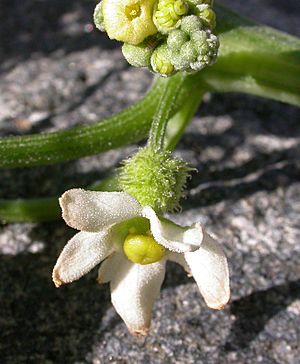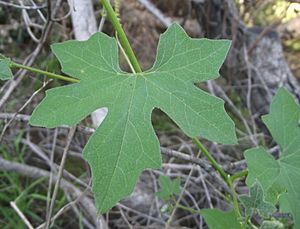Chilicothe facts for kids
Quick facts for kids Chilicothe |
|
|---|---|
 |
|
| Scientific classification | |
| Genus: |
Marah
|
| Species: |
macrocarpa
|
| Synonyms | |
|
Marah macrocarpus (orthographic variant) |
|
Marah macrocarpa (say "MAH-rah mak-roh-KAR-pah"), also known as chilicothe, wild cucumber, bigroot, or sometimes space pods, is a unique plant. It belongs to the Marah group of plants.
Contents
About the Wild Cucumber Plant
The Marah macrocarpa plant has fuzzy or hairy shoots, stems, and leaves. This helps it live in dry places where it naturally grows. Its vines start to grow in late winter when there's more rain. These vines can climb or spread out up to 6 meters (about 20 feet) long!
These vines grow from a very large, hard root that is like a giant potato. This root can be several meters long and weigh over 100 kilograms (about 220 pounds)! The vines grow very quickly. They develop leaves, flowers, and even fruit fast. Often, the first parts of the new vines already have male and female flowers. The leaves usually have five main parts, but their size and shape can be different on different plants.
Flowers of the Wild Cucumber
The flowers of Marah macrocarpa can be yellowish-green, cream, or white. They appear soon after the vine starts to grow. This plant has both male and female flowers on the same plant. This is called being monoecious. The male flowers grow in open groups. The female flowers, which have a swollen base, usually grow by themselves. The plant can fertilize itself, meaning pollen from its own male flowers can fertilize its female flowers. Insects help with this process.
The Fruit of the Wild Cucumber
The fruit of this plant is longer than it is wide. It's about 5–6 cm (2–2.4 inches) across and 15–20 cm (6–8 inches) long. It's covered in sharp prickles that can be up to 1 cm long, but they don't have hooks. When the fruit is young, it's bright green. As it gets older, it turns yellow. The fruit swells up as it ripens. Eventually, it bursts open to release its large seeds. Fruits start to grow in late winter and are ripe by early summer.
Seeds and How They Grow
The seeds of Marah macrocarpa are big, hard, and very smooth. The wild cucumber found in Southern California has larger seeds than most other Marah species, except for Marah horridus. Each fruit usually holds four or more seeds. These seeds start to grow in the cool, wet weather of late winter.
They have a very interesting way of sprouting! First, a shoot grows out of the seed and goes downward into the ground. Then, this shoot splits into two parts. One part starts to swell and forms the large root (tuber). The second part grows back up to the surface and becomes the vine you see above ground.
Where the Wild Cucumber Grows
This plant is native to Southern California and Baja California in Mexico. You can find it from the Transverse Ranges and Channel Islands down through the Peninsular Ranges.
It likes to grow near streams, in dry riverbeds (called washes), and on hillsides. It's often found in areas with chaparral (a type of shrubland) and oak woodlands. It can grow at elevations up to 900 meters (about 3,000 feet). The plant can handle different types of soil and acidity. However, it needs soil that is moist during certain times of the year. The vines can grow in full sunlight or in partly shaded spots. It pops up soon after the winter rains begin, grows until late spring, and then completely dies back during the hot, dry summer.
How People Use Wild Cucumber
All parts of the Marah macrocarpa plant taste very bitter. The name Marah actually comes from Hebrew and means "bitter." Even though it's bitter, the leaves have sometimes been used as a vegetable. The large root of the plant can also be processed to make a substance that is similar to soap.



